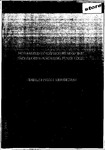AUTOMATED INTERPRETATION OF THE BACKGROUND EEG USING FUZZY LOGIC
| dc.contributor.author | RIDDINGTON, EDWARD PETER | |
| dc.contributor.other | School of Engineering, Computing and Mathematics | en_US |
| dc.date.accessioned | 2012-08-03T11:22:49Z | |
| dc.date.available | 2012-08-03T11:22:49Z | |
| dc.date.issued | 1998 | |
| dc.identifier | Not available | en_US |
| dc.identifier.uri | http://hdl.handle.net/10026.1/1109 | |
| dc.description.abstract |
A new framework is described for managing uncertainty and for deahng with artefact corruption to introduce objectivity in the interpretation of the electroencephalogram (EEG). Conventionally, EEG interpretation is time consuming and subjective, and is known to show significant inter- and intra-personnel variation. A need thus exists to automate the interpretation of the EEG to provide a more consistent and efficient assessment. However, automated analysis of EEGs by computers is complicated by two major factors. The difficulty of adequately capturing in machine form, the skills and subjective expertise of the experienced electroencephalbgrapher, and the lack of a reliable means of dealing with the range of EEG artefacts (signal contamination). In this thesis, a new framework is described which introduces objectivity in two important outcomes of clinical evaluation of the EEG, namely, the clinical factual report and the clinical 'conclusion', by capturing the subjective expertise of the electroencephalographer and dealing with the problem of artefact corruption. The framework is separated into two stages .to assist piecewise optimisation and to cater for different requirements. The first stage, 'quantitative analysis', relies on novel digital signal processing algorithms and cluster analysis techniques to reduce data and identify and describe background activities in the EEG. To deal with artefact corruption, an artefact removal strategy, based on new reUable techniques for artefact identification is used to ensure that artefact-free activities only are used in the analysis. The outcome is a quantitative analysis, which efficiently describes the background activity in the record, and can support future clinical investigations in neurophysiology. In clinical practice, many of the EEG features are described by the clinicians in natural language terms, such as very high, extremely irregular, somewhat abnormal etc. The second stage of the framework, 'qualitative analysis', captures the subjectivity and linguistic uncertainty expressed.by the clinical experts, using novel, intelligent models, based on fuzzy logic, to provide an analysis closely comparable to the clinical interpretation made in practice. The outcome of this stage is an EEG report with qualitative descriptions to complement the quantitative analysis. The system was evaluated using EEG records from 1 patient with Alzheimer's disease and 2 age-matched normal controls for the factual report, and 3 patients with Alzheimer's disease and 7 age-matched nonnal controls for the 'conclusion'. Good agreement was found between factual reports produced by the system and factual reports produced by qualified clinicians. Further, the 'conclusion' produced by the system achieved 100% discrimination between the two subject groups. After a thorough evaluation, the system should significantly aid the process of EEG interpretation and diagnosis. | en_US |
| dc.language.iso | en | en_US |
| dc.publisher | University of Plymouth | en_US |
| dc.title | AUTOMATED INTERPRETATION OF THE BACKGROUND EEG USING FUZZY LOGIC | en_US |
| dc.type | Thesis | |
| dc.identifier.doi | http://dx.doi.org/10.24382/3580 | |
| dc.identifier.doi | http://dx.doi.org/10.24382/3580 |
Files in this item
This item appears in the following Collection(s)
-
01 Research Theses Main Collection
Research Theses Main


